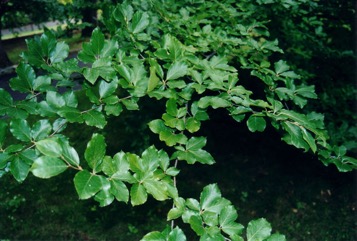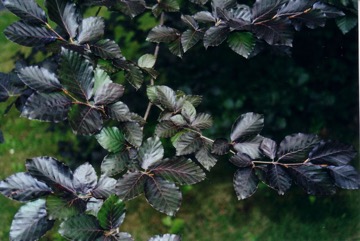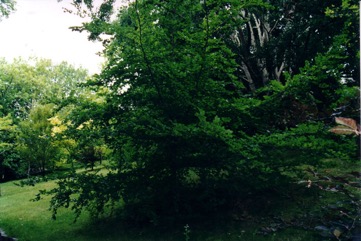Beech, European beech, English beech

It is a temperate plant. It is a native of Europe. It needs a well drained soil. It can grow in alkaline soils. It suits hardiness zones 5-9. Arboretum Tasmania.
Also known as:
Bikfa, Buk, Bukev, Bukk, Bukva, Bukvica, Faggio, Faya, Haya, Hayuco, Majusfa, Pagoa
Synonyms
- Fagus sylvatica var. pendula
Edible Portion
- Nuts, Seeds, Leaves, Seeds - oil, Wood - flavouring, Sap, Flower buds
Where does Beech grow?
Found in: Albania, Australia, Balkans, Bosnia, Britain, Bulgaria, Czech Republic, Europe, France, Greece, Haiti, Hungary, India, Italy, Luxembourg, Macedonia, Norway, North America, Romania, Scandinavia, Slovakia, Slovenia, Spain, Sweden, Switzerland, Tasmania, United States, West Indies
Notes: There are 10 Fagus species.
Status: The fruit are eaten by children.
Growing Beech, European beech, English beech
Cultivation: Plants can be grown from seed. Seeds only grow poorly. Plants also put out suckers which can be cut off and planted. Seeds need cold treatment for 3-4 months.
Edible Uses: The kernels of the nuts are eaten, raw or roasted and salted. The kernel produces an oil good for cooking food in. The oil is also used for salads. It is made into beechwood butter. The young leaves are eaten raw in salads. They are also used in liqueurs. The wood is used for ageing beers and for smoking hams.
Production: Plants grow slowly. Grafted trees produce in 3-4 years. The nuts are collected after falling.
Nutrition Info
per 100g edible portion| Edible Part | Energy (kcal) | Protein (g) | Iron (mg) | Vitamin A (ug) | Vitamin c (mg) | Zinc (mg) | % Water |
|---|---|---|---|---|---|---|---|
| - | - | - | - | - | - |
Beech, European beech, English beech Photos



References
Abbet, C., et al, 2014, Ethnobotanical survey on wild alpine food plants in Lower and Central Valais (Switzerland). Journal of Ethnopharmacology 151 (2014) 624–634
Ambasta, S.P. (Ed.), 2000, The Useful Plants of India. CSIR India. p 219
Bremness, L., 1994, Herbs. Collins Eyewitness Handbooks. Harper Collins. p 55
Brickell, C. (Ed.), 1999, The Royal Horticultural Society A-Z Encyclopedia of Garden Plants. Convent Garden Books. p 433
Brown, D., 2002, The Royal Horticultural Society encyclopedia of Herbs and their uses. DK Books. p 212
Crawford, M., 2012, How to grow Perennial Vegetables. Green Books. p 75
Coombes, A.J., 2000, Trees. Dorling Kindersley Handbooks. p 152
Cundall, P., (ed.), 2004, Gardening Australia: flora: the gardener's bible. ABC Books. p 596 (Also as Fagus sylvatica var. pendula)
Denes, A., et al, 2012, Wild plants used for food by Hungarian ethnic groups living in the Carpathian Basin. Acta Societatis Botanicorum Poloniae 81 (4): 381-396
Etherington, K., & Imwold, D., (Eds), 2001, Botanica's Trees & Shrubs. The illustrated A-Z of over 8500 trees and shrubs. Random House, Australia. p 322
Facciola, S., 1998, Cornucopia 2: a Source Book of Edible Plants. Kampong Publications, p 115
Flowerdew, B., 2000, Complete Fruit Book. Kyle Cathie Ltd., London. p
Glowinski, L., 1999, The Complete Book of Fruit Growing in Australia. Lothian. p 137
Gouldstone, S., 1978, Australian and New Zealand Guide to food bearing plants. Books for Pleasure. p 44
Gouldstone, S., 1983, Growing your own Food-bearing Plants in Australia. Macmillan p 135
Harris, E & J., 1983, Field Guide to the Trees and Shrubs of Britain. Reader's Digest. p 72
Hedrick, U.P., 1919, (Ed.), Sturtevant's edible plants of the world. p 305
Hibbert, M., 2002, The Aussie Plant Finder 2002, Florilegium. p 101 (As Fagus sylvatica var. pendula)
Irving, M., 2009, The Forager Handbook, A Guide to the Edible Plants of Britain. Ebury Press p 55
Joyce, D., 1998, The Garden Plant Selector. Ryland, Peters and Small. p 111
Kermath, B. M., et al, 2014, Food Plants in the Americas: A survey of the domesticated, cultivated and wild plants used for Human food in North, Central and South America and the Caribbean. On line draft. p 365
Little, E.L., 1980, National Audubon Society Field Guide to North American Trees. Alfred A. Knopf. p 381
Lord, E.E., & Willis, J.H., 1999, Shrubs and Trees for Australian gardens. Lothian. p 55
Luczaj, L., 2012, Ethnobotanical review of wild edible plants of Slovakia. Acta Societatis Botanicorum Poloniae 81(4):245-255
Lyle, S., 2006, Discovering fruit and nuts. Land Links. p 201
Mabey, R., 1973, Food for Free. A Guide to the edible wild plants of Britain, Collins. p 33, 83
Menendez-Baceta, G., et al, 2012, Wild edible plants traditionally gathered in Gorbeialdea (Biscay, Basque Country) Genetic Reources and Crop Evolution 59:1329-1347
Menninger, E.A., 1977, Edible Nuts of the World. Horticultural Books. Florida p 17
Michael, P., 2007, Edible Wild Plants and Herbs. Grub Street. London. p 19
Morley, B. & Everard, B., 1970, Wild Flowers of the World. Ebury press. Plate 12
Nedelcheva A., 2013, An ethnobotanical study of wild edible plants in Bulgaria. EurAsian Journal of BioSciences 7, 77-94
Paoletti, M.G., Dreon, A.L., and Lorenzoni, G.G., 1995, Pistic, Traditional Food from Western Friuli, NE Italy. Economic Botany 49(1) pp 26-30
Pardo-de-Santayana, M., et al, 2005, The gathering and consumption of wild edible plants in the Campoo (Cantabria, Spain). International Journal of Food Sciences and Nutrition. 56(7): 529-542
Pieroni, A., 1999, Gathered wild food plants in the Upper Valley of the Serchio River (Garfagnana), Central Italy. Economic Botany 53(3) pp 327-341
Pieroni, A. et al, 2013, One century later: the folk botanical knowledge of the last remaining Albanians of the upper Reka Valley, Mount Korab, Western Macedonia. Journal of Ethnobiology and Ethnomedicine. 9:22
Plants for a Future database, The Field, Penpol, Lostwithiel, Cornwall, PL22 0NG, UK. http://www.scs.leeds.ac.uk/pfaf/
Plants of Haiti Smithsonian Institute http://botany.si.edu/antilles/West Indies
Redzic, S. J., 2006, Wild Edible Plants and their Traditional Use in the Human Nutrition in Bosnia-Herzegovina. Ecology of Food and Nutrition, 45:189-232
Ryan, S., 2008, Dicksonia. Rare Plants Manual. Hyland House. p 26
Sansanelli, S., et al, 2014, Wild food plants traditionall consumed in the area of Bologna (Emilia Romagna region, Italy). Journal of Ethnobiology and Ethnomedicine 10:69
Schuler, S., (Ed.), 1977, Simon & Schuster's Guide to Trees. Simon & Schuster. No. 110
Sfikas, G., 1984, Trees and shrubs of Greece. Efstathiadis Group. Athens. p 156
Simkova, K. et al, 2014, Ethnobotanical review of wild edible plants used in the Czech Republic. Journal of Applied Botany and Food Quality 88, 49-67
Sp. pl. 2:998. 1753
Svanberg, I. et al, 2012, Uses of tree saps in northern and eastern parts of Europe. Acta Societatis Botanicorum Poloniae 81 (4): 343-357
Tardio, J., et al, Ethnobotanical review of wild edible plants in Spain. Botanical J. Linnean Soc. 152 (2006), 27-71
van Wyk, B., 2005, Food Plants of the World. An illustrated guide. Timber press. p 153
Wickens, G.E., 1995, Edible Nuts. FAO Non-wood forest products. FAO, Rome. p 125
Young, J., (Ed.), 2001, Botanica's Pocket Trees and Shrubs. Random House. p 377